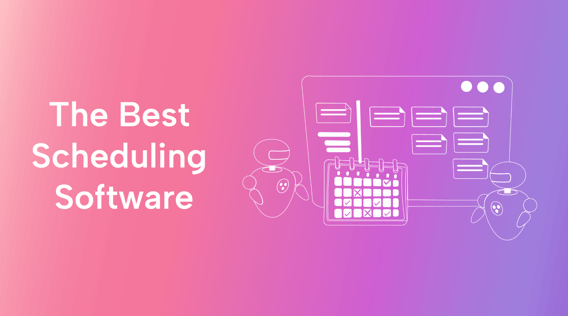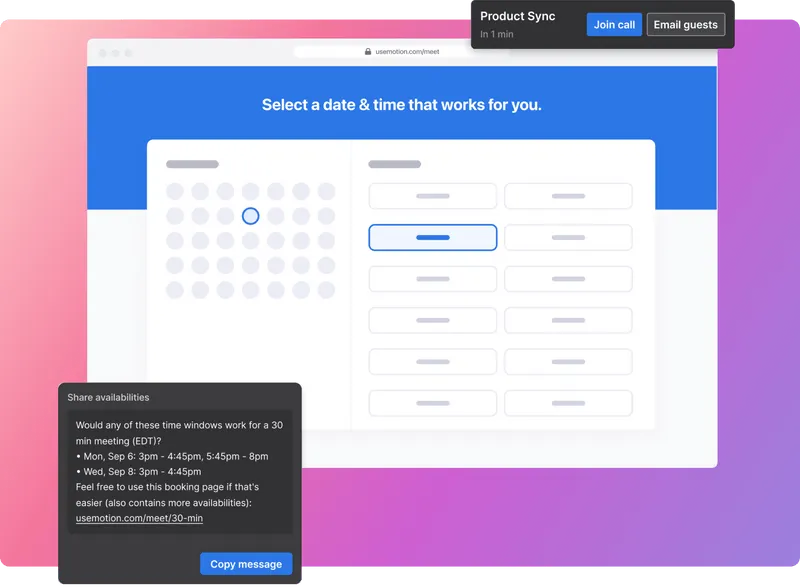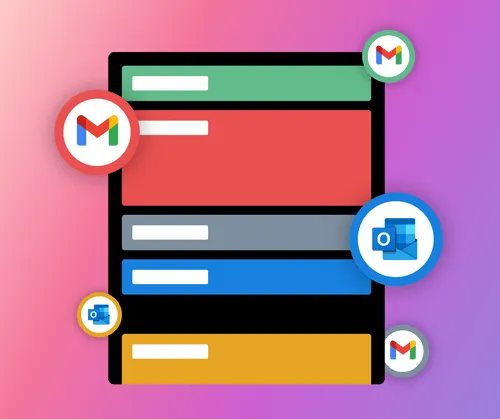Are you a business owner or manager struggling to keep your team and business schedules organized? Are scheduling conflicts, missed appointments, and task allocation causing headaches?
Inefficient scheduling can eat into your precious time and impact your bottom line.
But what if we told you there’s an excellent solution — one that can change how you make and run schedules?
Well, there is. And it comes in the form of smart scheduling software.
In this article, we’ll review what you need to know about scheduling tools, their benefits, and things to look for. We’ll also guide you through the best tools in the market.
What is scheduling software?
Scheduling software is a digital tool that can help you tame the chaos of your daily schedule. It can help you move, plan, and rearrange your to-do list or project tasks in an efficient, easy-to-manage way.
Let's say you have a busy week ahead, with many meetings, upcoming appointments, and deadlines. With scheduling software, you can input all of these activities into one interface (usually in an online calendar) so they're neatly organized and easy to manage.
This type of software often has an intuitive interface that allows you to easily adjust your tasks or add new ones to your schedule.
A helpful feature most scheduling tools offer is automatic notifications about upcoming items in your schedule or delays. Some tools even sync effortlessly with your email account.
Here are a few practical uses of scheduling software:
- Small business owners can lock in employee work schedules, customer appointments, and daily operations.
- Entrepreneurs can schedule daily work, such as meetings or scouting new customers.
- Students can track all their academic commitments.
- Event planners can schedule events.
- Service businesses, like construction companies, can use it to plan both long- and short-term projects.
- Or you can simply use it for personal commitments like family get-togethers, dream vacations, or exercise routines.
Types of scheduling software
Online scheduling tools have been around since the dawn of the modern digital age. The first tools were (painfully) simple calendars businesses used to track their tasks.
Luckily, these tools have come a long way and evolved into the various scheduling tools we have now, from simple (like Google Calendar) to bespoke appointment scheduling apps.
Appointment-scheduling software
If you run a busy salon, doctor’s office, or fitness center, then you probably need an appointment scheduling app.
Appointment scheduling apps enable your clients to easily book appointments online. This reduces the number of back-and-forth emails and phone calls you must handle.
As a business owner or manager, you also get a well-organized schedule.
Plus, many of these tools will send automatic reminders to both you and your clients.
Employee scheduling software
If you run a restaurant, a retail business, or any other company that uses shift-based work, then employee scheduling software is for you. This tool simplifies the creation of work schedules while balancing capacities and priorities.
With scheduling software, you simply input your employees' availability, and the tool generates optimized schedules.
Project scheduling software
Creating project schedules — and sticking to them — is hard. Change requests, new projects or team members, or delays can throw a theoretical wrench into your often perfect schedule.
To make it worse, more than 25% of project managers report building project schedules using Excel, Word, or PowerPoint. This is inefficient and can be prone to human error.
With project scheduling software (or project management software), you can more easily create error-free project schedules. And when those tricky changes do occur, you can easily reschedule what you need to.
With a tool like Motion, you can track tasks, deadlines, and resource allocation. You can also assign responsibilities, set milestones, and see the big picture of even complex projects at a glance.
Project management tools also typically feature visual tools, like Gantt charts and project timelines, which project managers use to build accurate project schedules.
Even better, project teams can use the collaboration features that often come with project management software to help them collaborate (and get their work done).
Production scheduling software
Production scheduling software is perfect for manufacturing (or businesses that produce many products).
Production schedules need to be tight and error-free to avoid costly delays. Production scheduling software does just that.
Personal scheduling apps
Entrepreneurs, students, and pro athletes alike use personal scheduling apps. They use these tools to plan and schedule meetings, tasks, family events, their training programs, and self-care.
Some apps can balance your work and personal life, as well as track your habits so they can give you smart recommendations.
Benefits of online scheduling software
Using scheduling software has many benefits. Let's dig deeper into a few of these.
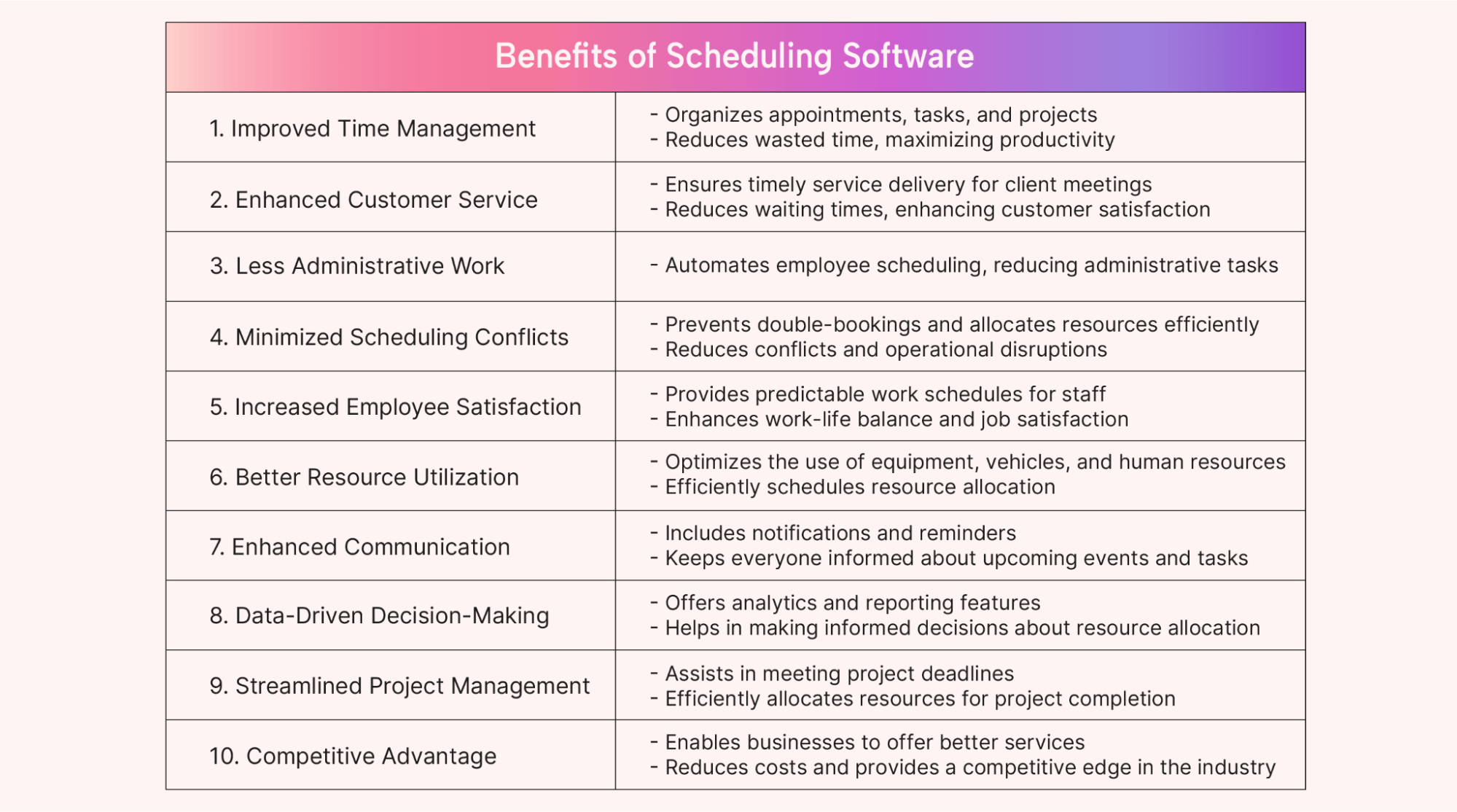 |
Improved bottom line
Most managers and business owners understand the endless hours it takes to craft employee schedules (not to mention adjusting the schedules for changes).
Employee scheduling software and various project management tools can automate the scheduling process. With them, you can offload some of your administrative work to the software.
Less time spent on admin work means you can focus more on satisfying your customers, and improved customer experience leads to a better bottom line.
Better resource utilization
Businesses rely on various resources, including equipment, vehicles, and staff. Not optimizing for these can be costly.
For example, if you run a delivery company and one of your drivers is sick, your customers might receive their products late. With a scheduling tool, you can adjust the other drivers' schedules to deliver the products on time. You can also cut idle time by optimizing schedules.
Finally, double bookings and scheduling conflicts aren't just frustrating — they're costly. If two drivers arrive at the same customer's house, you've wasted a lot of time.
Improved productivity
Scheduling conflicts also impact you and your team's productivity. Double booking and the like means double the work (and maybe inferior quality).
Scheduling software can do more than just save you time. It can help you maximize time by optimizing schedules, such as cutting unimportant tasks from your to-do list.
Better time management usually leads to better productivity. And when you and your team aren't overworked or rushed, quality tends to improve.
Data-driven decision-making
Most scheduling software solutions offer analytics and reporting, which you can use to help make decisions (in real-time) regarding resource usage and operations.
Let's say the manager of the delivery company uses the tool to see which drivers are taking too long on their deliveries. The scheduling tool provides that data instantly, allowing the manager to make adjustments on the fly.
What sets smart scheduling software apart from traditional scheduling software?
87% of businesses worldwide believe that artificial intelligence and automation are key to gaining a competitive edge in their industry.
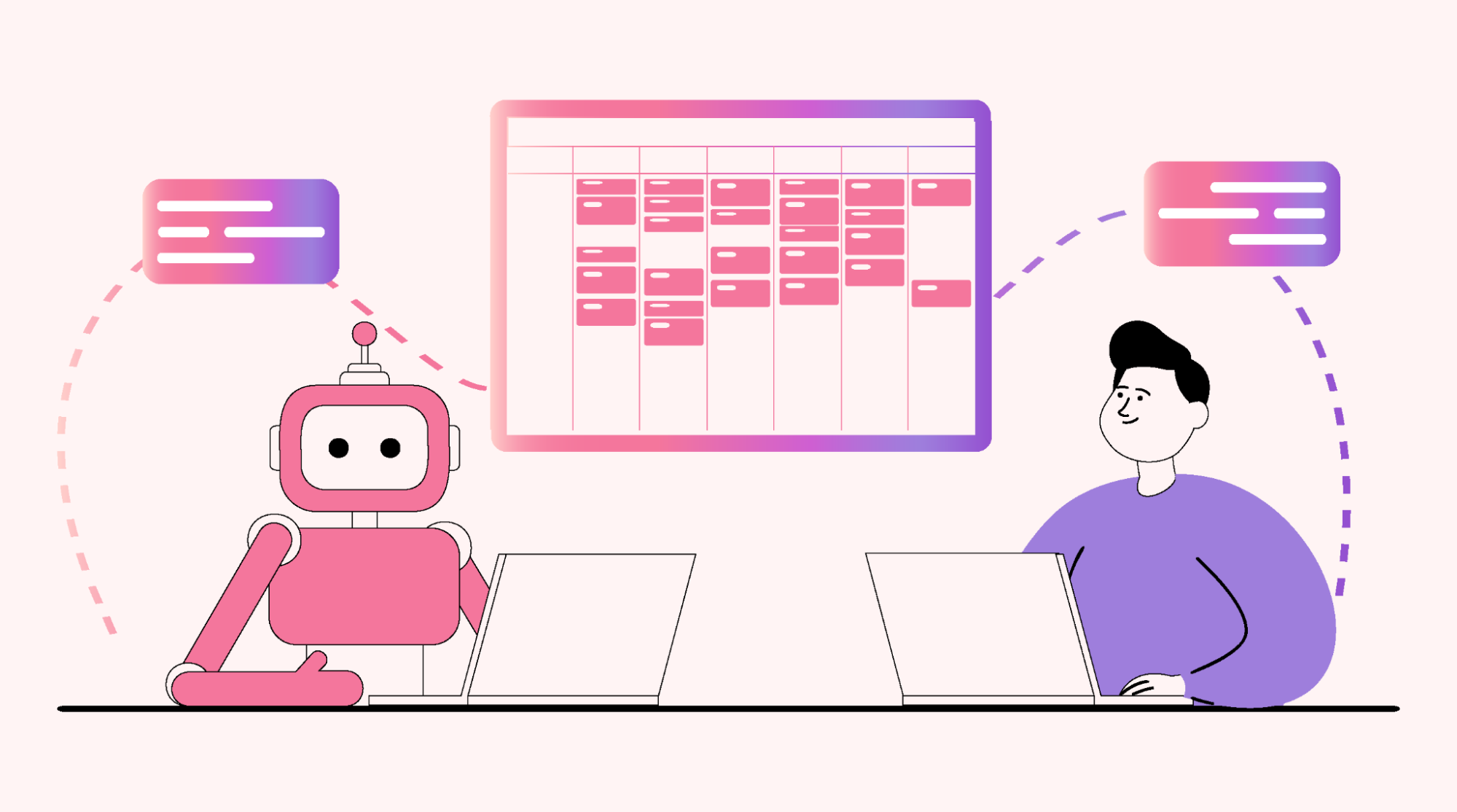 |
AI scheduling software has many key features that can help you gain that competitive edge. Let's see what this would look like for a delivery company that started using smart scheduling software.
Better data
It all starts with data.
The AI system gathers real-time data about the activities the delivery teams complete. This data is housed in a central database, which the AI system can effortlessly analyze (24/7). It'll crunch the data on aspects like the number of deliveries done each day, delivery goals, overall capacity, and more. This means you'll always have the most timely, accurate data.
Better analyses
With more (and better) data, AI will then use machine learning to instantly process that data to look for patterns. After the software has crunched the data, it notices that the delivery company is two times more busy on Fridays. With this analysis, the company can adjust delivery schedules or hire more drivers.
The software also anticipates peak delivery times, which further helps with scheduling.
And because AI works 24/7 in the background, you'll have more confidence in the analysis it spits out.
Automated scheduling
Since smart schedulers have the most up-to-date data on individual schedules and incoming orders, they can even take over scheduling decisions for you. The app can (continuously) build and adjust the delivery team schedules each day.
The AI system can also send real-time updates to managers, customers, and team members, so no second-guessing about who should be doing what and when.
AI software is highly adaptable, so if a driver calls in sick, the software can automatically find a replacement and adjust schedules accordingly. If an order is canceled, the AI scheduler can quickly replan deliveries "without breaking a byte."
Automated scheduling means the delivery company can deliver more products (on time), improve the customer experience, and (ultimately) save money.
What to look for in the best (smart) scheduling software
There are a few essential things to keep in mind before you jump into an AI-powered scheduler. Look for the following elements before you commit.
User-friendliness
No one wants to spend hours calibrating and setting up software or tools to get it to work. In the Apple ecosystem, when you buy a pair of earbuds, you can (literally) use it right out of the box.
Look for a scheduling tool that's easy to use right out of the box, with an intuitive, user-friendly interface. Drag-and-drop functionality and premade templates can make your life much easier.
Integration capabilities
You likely already use tools like a CRM system, calendars, and accounting software. It's vital that your new scheduling software can work with those.
Look for smart scheduling software that can play nicely with your existing tools. You'll want out-of-the-box calendar integration, and for it to play nicely with tools like Google Drive, Google Meet, Google Analytics, and other standard business systems.
Scalability
What if you're getting clients, hiring employees, and booking appointments faster than you expected? Your system should be able to handle higher workloads and grow effortlessly.
Look for a tool that can handle many users (and clients), as well as online booking functionality for scheduling meetings and appointments.
Motion: The best scheduling software
Motion takes project, business, and team scheduling to the next level with its AI scheduler, AI task manager and AI meeting assistant.
Automated task allocation
Motion's AI scheduler factors in your team members' strengths and availability and can then automatically assign tasks accordingly.
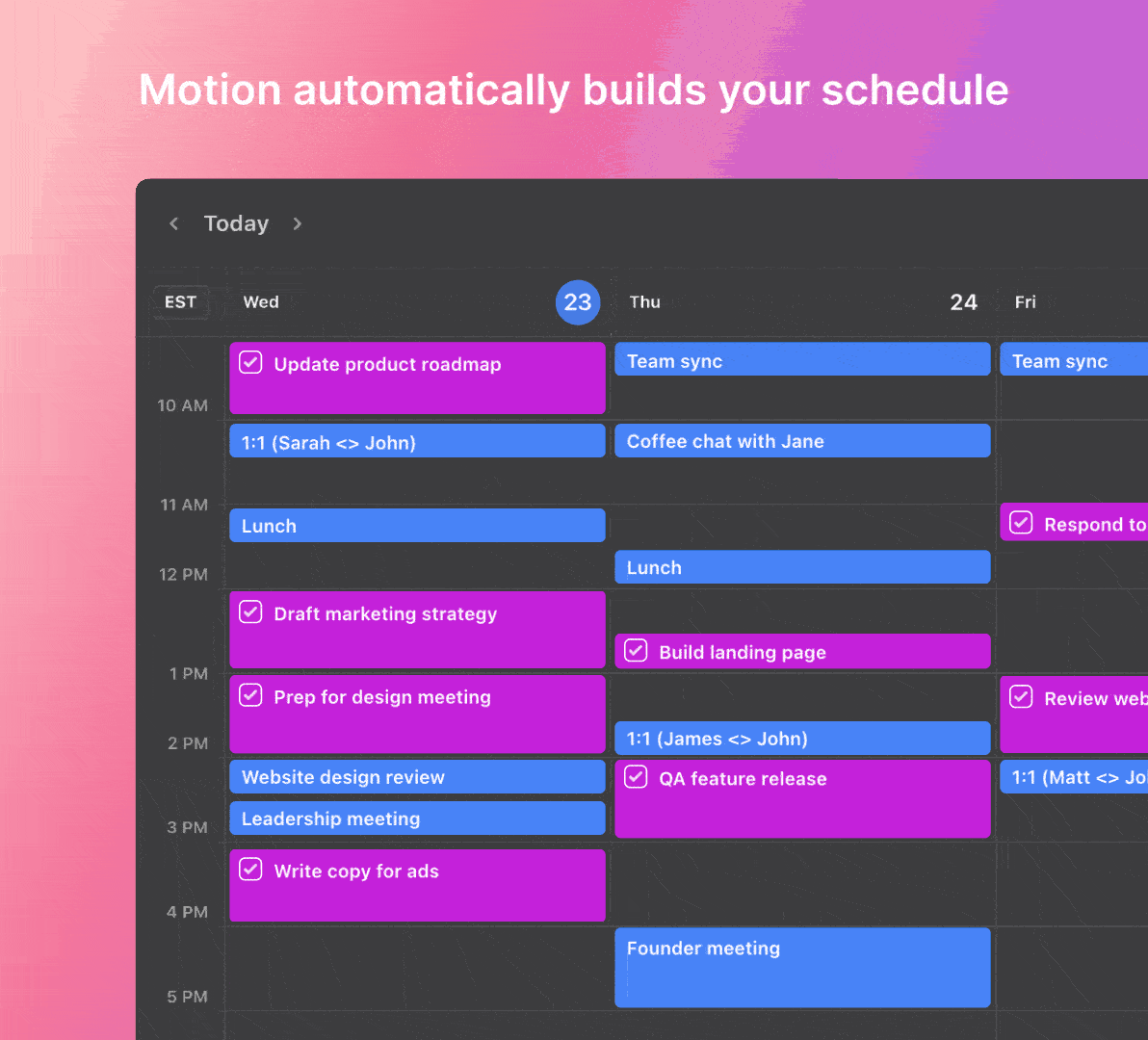 |
Motion's AI scheduler also adapts in real-time. If circumstances change (for example, a team member becomes unavailable), Motion's AI can adjust schedules to compensate for the absence. If it can't, it'll immediately let you know so you can step in proactively.
Optimized team schedules
Motion’s AI excels at creating team schedules that are finely tuned to the business’s needs. This means that workloads are balanced to prevent burnout and underutilization.
Automatic meeting scheduler
Motion’s AI meeting assistant can automate the booking process for client and team meetings. It integrates with most calendar management apps and can read those calendars to find time slots for event scheduling and meetings that work for everyone.
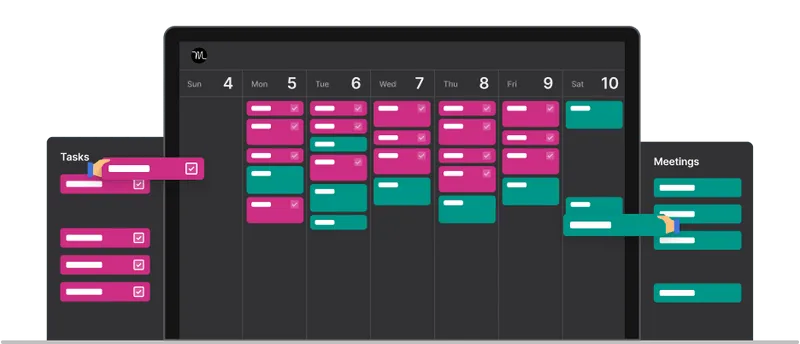 |
If you work with clients, Motion’s AI appointment scheduler can also work with their calendars. You can also customize your meeting preferences with preferred meeting times or durations.
Integration made easy
Motion is designed to integrate with various commonly used scheduling software. This way, you can consolidate all your scheduling data from other tools into one central task management platform.
Motion transforms how businesses handle their scheduling (and can do most of it independently).
Sign up for your 7-day free trial.

